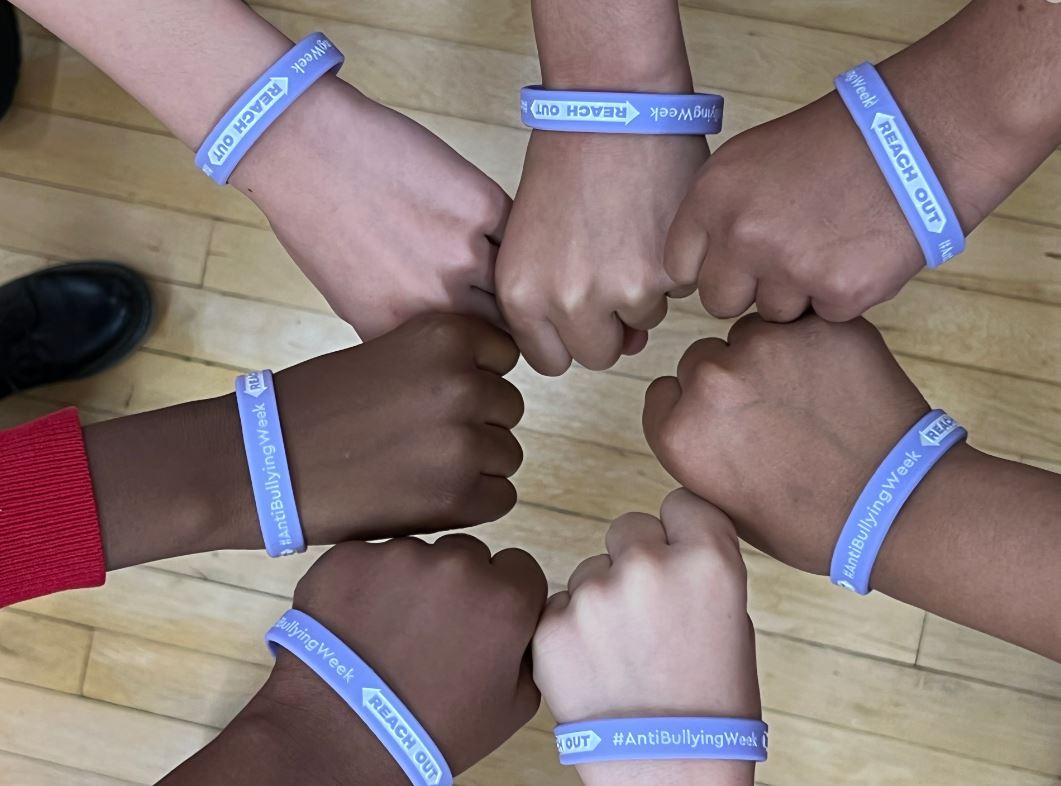Anti-Bullying
Bullying Definition
At John Burns Primary School, it is important that all stakeholders, including the children, have a shared understanding and definition of what bullying is.
We have adopted The Diana Award’s definition of bullying behaviour and the different types of bullying behaviour.
The Diana Award defines bullying behaviour as:
Repeated, negative behaviour that is intended to make others feel upset, uncomfortable or unsafe.
Additionally, we believe that for a behaviour to be considered bullying, it must be persistent and goes on over time and that it is deliberate and not accidental.
It is important to distinguish between normal growing up and finding your place in class or in the playground and real, systematic bullying. Not all unkind behaviour is bullying.
Types of bullying
At John Burns Primary School, we teach children that bullying can take place in four main contexts:
1. Verbal
This form of bullying can include repeated, sustained name calling, calling people unkind names and verbal threats of violence.
2. Physical
This form of bullying can include repeated, sustained hitting, kicking, biting, pushing, tripping a child up. Anything that hurts you by touching you.
3. Indirect
This form of bullying can include the repeated, sustained isolating of someone, leaving them out in classroom activities or on the playground, spreading rumours and giving threating looks.
4. Cyber/Online
This form of bullying can include the repeated, sustained sending of nasty messages (via text or social media), being part of group chats that encourage bullying, liking unkind messages on social media posts, filming or taking photos without permission and making prank calls.
How the school responds to an allegation of bullying
At John Burns Primary School, we aim to tackle bullying by trying to prevent it from happening in the first place and by tackling it consistently and fairly when it does.
Ways we are proactive (preventative)
At the start of the academic year, children complete a one-page profile in which they must reflect on themselves as a learner. As part of this, they must identify and name trusted adults. All of the children know that they should tell a trusted adult if they are worried or concerned about anything.
Weekly PSHE lessons are timetabled and delivered by class teachers which follow a comprehensive scheme of work from the PSHE Association. As part of the curriculum, children learn about aspects of bullying and how to prevent it.
Leaders, teachers and support staff continually link all aspects of behaviour, including anti-bullying messages, to the six school values:
- Try your best
- Take Responsibility
- Co-operate
- Show Respect
- Be Kind
- Be Positive
This is achieved through the presence and visibility of the school values around the school building, including classrooms; as well as through weekly assemblies and fortnightly school value badge award assemblies.
The Year 6 Prefect Team contribute to anti-bullying by creating a child-friendly anti-bullying leaflet which is then shared with all children and parents. Click here to read the child-friendly anti-bullying leaflet (January 2023).
Furthermore, the School Council (made up of children form Year 1 to Year 6) survey children in their class on a range of topics and can be approached by peers in their class if they have any worries or concerns.
Furthermore, we raise awareness through Anti-Bullying Weeks. These are held in November and have a key focus each year. This year’s theme was Reach Out.

In November 2021, a range of children from across the school, took part in an anti-bullying video - click here to hear the children saying their One Kind Word.

Ways we respond to an allegation of bullying
If an allegation of bullying is made by a child or by a parent, in the first instance the child’s class teacher will undertake an investigation to ascertain details from the alleged victim and the alleged perpetrator. The class teacher will inform a senior leader who may support in the investigation or liaise with the parent/s.
Following the initial investigation, a decision will be made to decide if the allegation of bullying is founded.
OUTCOME 1:
The investigation has shown unkind behaviour by a child/children but it is not deemed to be bullying (not meeting our shared characteristics cited above).
ACTION:
- Parents of the alleged victim will be informed of the investigation outcome either by letter or in a face-to-face meeting.
- Individual children will be spoken to by their class teacher or a senior leader about how their actions and behaviour have made another child feel.
- Bespoke PSHE lessons or circle times will be delivered by the class teacher to address behaviours specific to the allegation.
- The class teacher and Senior Leadership Team will continue to informally monitor the children involved.
OUTCOME 2:
The investigation has shown behaviour by a child/children is deemed to be bullying (meeting aspects of our shared characteristics cited above).
ACTION:
- Parents of the victim will be informed of the investigation outcome either by letter or in a face-to-face meeting.
- Individual children will be spoken to by their class teacher or a senior leader about how their actions and behaviour have made another child feel.
- Parents of the perpetrator/s will be contacted and a meeting will take place to inform them of the behaviours.
- Bespoke PSHE lessons or circle times will be delivered by the class teacher to address behaviours specific to the allegation.
- The perpetrator/s will be given the chance to change their behaviour.
- The class teacher and Senior Leadership Team will formally monitor the children involved and report back to all parents involved after a pre-determined period of time.
How can parents help their children?
The following guidelines may be useful for parents to deal with issues as they arise:
My child is unhappy and has fallen out with his or her friends.
ACTION: talk to your child. Talk about feelings and how to play together. Ask your child if s/he can play with another friend. Teach your child how to share and get on with others.
My child is still unhappy and does not seem to have friends.
ACTION: talk to your child’s teacher. Often a quick word can help resolve small problems. We can help your child choose a friend for playtimes. Our lunchtime supervisors and Teaching Assistants will look out for children who may be experiencing friendship difficulties.
My child is really unhappy and there seems to be a persistent, underlying problem.
ACTION: make an appointment with your child’s teacher to discuss the problem in depth. Make a further appointment in a couple of weeks’ time to see how things are going.
My child is still unhappy and the issues have not been resolved.
ACTION: make an appointment to see Mr Grogan or Mr Taylor-Graham.
Additional support for parents
The Anti-Bullying Alliance has produced a concise, clear guide for parents about anti-bullying. In addition to anti-bullying information, it also offers a range of activities for parents to complete with their child/ren at home to discuss bullying and advice that can be given to children at home.
Click here for the link to the interactive anti-bullying information tool for parents and carers.
Furthermore, these websites may be useful for parents: www.childline.org.uk ; www.kidscape.org.uk and www.parentline.org.uk


